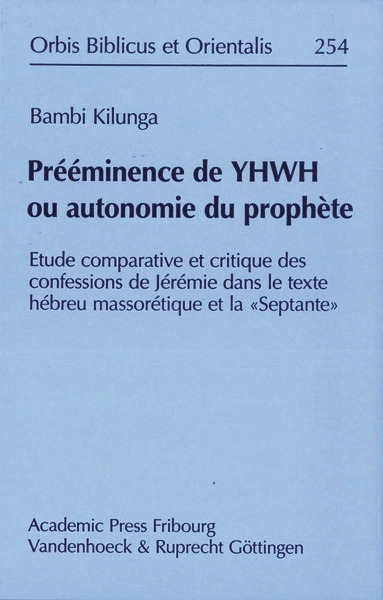

 0
EN
0
EN

Following important discoveries made in Qumran (and in the Judaean desert) of numerous biblical manuscripts and their progressive publication, many scholars have resumed afresh the study of the LXX and endeavored to reaffirm its importance for the exegesis and its place for the understanding of the most ancient history of the biblical text.
Bambi Kilumgas study of Jeremiah’s confessions (it is usually admitted that they are 5 in number: Jr. 11:18-12:6; 15:10-21; 17:12-18; 18:18-23; and 20:7-18) is set within the framework of this scientific enterprise which attempts to determine the relationship between the LXX and the MT of the book of Jeremiah. The retrospection of the research history and the subsequent discussion about the dating of the long form of the book of Jeremiah (chap. 1) aims at clarifying the different major trends in the works that are concerned with the study of the book of Jeremiah. The central part of the book (chap. 2) deals with a detailed comparative and critical study of the Hebrew textual form in the MT and the textual form of the LXX in order to verify whether the text of Jeremiah’s confessions is close or distant in the two textual forms. Also, by means of a deep analysis of some textual choices operated by each one of the two textual forms, we wish to bring to light (chap. 3) the particular manner in which each one of the two forms presents or characterizes Jeremiah. In the last chapter (chap. 4), we enquire whether the study of the confessions can clarify the chronological relationship between the two textual forms and can help to establish a relationship of priority of one textual form to another, and can eventually suggest a dating for these forms.
It turns out of this meticulous and critical synoptic study done on the confessions that the two textual forms generally represent a common text. The book of Jeremiah seems to have kept in the MT as well as in the LXX traces and important passages of a book that was initially conceived to be one and the same single book. Nevertheless, some differences (be they of textual or of literary type), noted between the two textual forms (MT and LXX) in the confessions, have enabled us to enlighten the process through which the Hebrew LXX model evolved towards the Hebrew Masoretic text.
As for knowing when and by whom these redactional changes were made, the observations presented in this study speak in favour of the period that immediately followed the end of the Babylonian exile, that is, the end of 6th century and the beginning of 5th century B.C., as being the most propitious time for a literary activity of such a scale.



